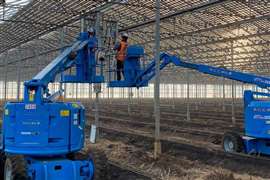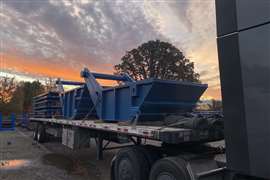Hydrospex 1,800 tonne tower system launch
08 December 2008

Tjerko Jurgens, Hydrospex managing director, gets straight to the point, "It requires a 3.45 million euro [US$4.3 million] investment and you can compete with - and beat - a 25 million dollar crane."
It is a modular containerised system that uses hydraulic strand jacks mounted atop a set of girders spanning two pairs of hydraulically self erecting lattice towers. The whole thing ships in 16 standard 20 foot containers, Jurgens says. In those containers will be the mast sections, the main girders, small components and the strand jacks. "Everything is in the containers, the skid tracks, even the lifting strands and hooks," Jurgens continues.
"This thing can lift 1,500 tonnes to a height of 60 m and is designed to exceed almost 80 m," Jurgens explains.
It can skid back and forth, it has side shift motion, and it has divisible main girders spanning from 14 to 24 m. The main girders are made in sections and pinned together so the two end pieces can be used together or a centre section can be added.
It is rated for 1,200 tonnes to 60 m without guy ropes, where the top girders are 24 m long and there are two 600 tonne strand jacks. The 1,500 tonnes capacity is with suitable strand jacks and without the centre section in the main girders. At 35 m it is rated for 1,800 tonnes.
Pushing it up
For erection, "There is a lifting mechanism which you put on the skid track that lifts the gantry up by three feet [1 m] at a time and you put in a new column section from below," explains Jurgens. It is a push-up method. No guy ropes or ground anchors are needed as these are impossible to find space for in refineries, Jurgens says.
The columns are built up using 1 m steel fabricated octagonal sections of T1 (S690) quality steel plate folded and welded on a robotic welding facility "here in our workshops where we build everything ourselves." The sections have a twist lock - they are put in at the bottom of the towers and then rotated 90 degrees to lock them in place to the section above, before being pushed up hydraulically, ready for the next section.
Make it simple
A key requirement of the design was that the tower system must be simple to erect. "At first glance it looks as though it is labour intensive to build it, which is true, lots of manual work is needed to put it together." There are, however, several factors to be considered and lots of provisions have to be made, for example, that no parts heavier than 25 kg need to be handled manually.
"The other thing that is even more important is that where a competing crane user is shipping a 25 million dollar machine across the ocean via ships, rail, trucks, etc. and the crane owner needs to use their own qualified personnel, whereas, with our system you send a supervisor with the machine and hire local labour, just for that job, to put it together and to take it apart," says Jurgens.
Continuing with the assembly, the lattice bracings for the towers are pinned in as the towers rise. The whole thing is built at ground level. There is no sky-work in its assembly or operation. A 100 tonne mobile crane is the only other external lifting equipment needed. This assist crane is used to put the main girders and strand jacks into position before the tower is raised.
Commissioning started on 10 November and the first H SET system, sold to Burkhalter in the US (and designated B SET for Burkhalter), will be built to the full height for a test lift at the Hydrospex factory in Hengelo, the Netherlands, before shipping US on 1 December.
Burkhalter has a local refinery where the job is to erect two 1,000 tonne 50 m tall vessels. "This is the typical thing that my idea will be good for. And I had a little bit of luck in that there were no cranes available, in the time window that was given. It was an existing live refinery so they had no room or time to build a crane. So, both the customer and my client were forced to look for an alternative. That was the moment we presented them with the H SET, Jurgens explains.
Jurgens sees a bright future for the H SET, "Our forecast is to build four systems. We are going to start straight away building the second system as soon as we have finished the first. We can build a system like that in about three months. I know they will sell."
For more news on Burkhalter and the new system see American Cranes & Transport December 2008, p54.






